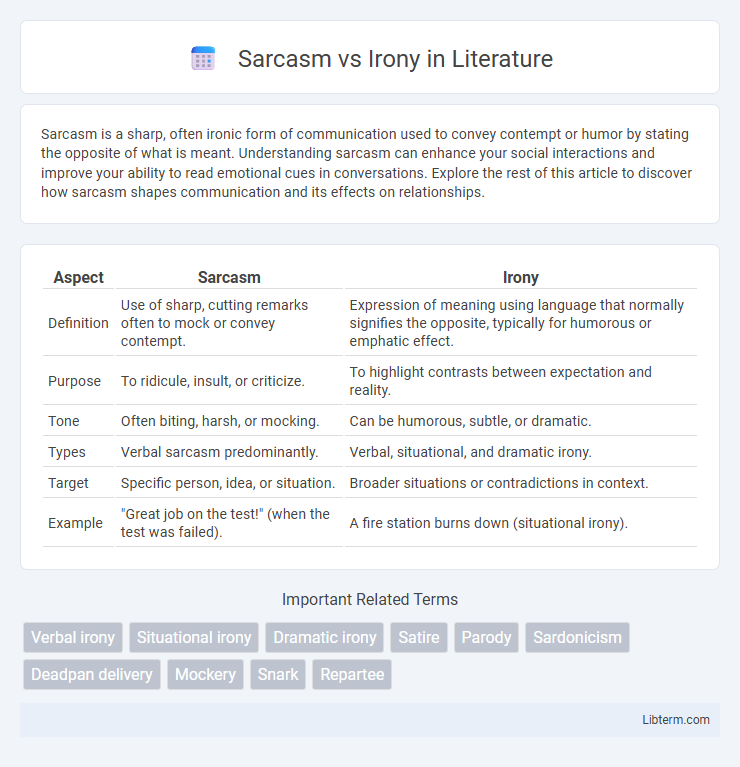Sarcasm is a sharp, often ironic form of communication used to convey contempt or humor by stating the opposite of what is meant. Understanding sarcasm can enhance your social interactions and improve your ability to read emotional cues in conversations. Explore the rest of this article to discover how sarcasm shapes communication and its effects on relationships.
Table of Comparison
| Aspect | Sarcasm | Irony |
|---|---|---|
| Definition | Use of sharp, cutting remarks often to mock or convey contempt. | Expression of meaning using language that normally signifies the opposite, typically for humorous or emphatic effect. |
| Purpose | To ridicule, insult, or criticize. | To highlight contrasts between expectation and reality. |
| Tone | Often biting, harsh, or mocking. | Can be humorous, subtle, or dramatic. |
| Types | Verbal sarcasm predominantly. | Verbal, situational, and dramatic irony. |
| Target | Specific person, idea, or situation. | Broader situations or contradictions in context. |
| Example | "Great job on the test!" (when the test was failed). | A fire station burns down (situational irony). |
Understanding Sarcasm: Definition and Key Features
Sarcasm is a form of verbal irony characterized by mocking or contemptuous remarks intended to convey the opposite of their literal meaning. Key features include a sharp tone, exaggeration, and context-dependent cues that signal the speaker's actual intent. Understanding sarcasm requires recognizing these vocal and situational indicators that distinguish it from straightforward statements.
Exploring Irony: Types and Characteristics
Irony manifests in three primary types: verbal, situational, and dramatic, each characterized by a contrast between expectation and reality. Verbal irony occurs when a speaker says the opposite of what they mean, often to emphasize a point, while situational irony involves events that unfold contrary to what was anticipated. Dramatic irony arises in narratives when the audience knows crucial information that the characters do not, creating tension and deeper engagement.
Historical Origins of Sarcasm and Irony
Sarcasm traces back to Ancient Greek, derived from the word "sarkazein," meaning "to tear flesh," highlighting its biting and cutting nature in verbal exchange. Irony, with origins in the Ancient Greek term "eironeia," signified a form of feigned ignorance used by Socratic dialogues to expose truth through contrast. Both concepts evolved through literature and rhetoric, with irony emphasizing contrast between appearance and reality, while sarcasm specializes in bitter, mocking remarks.
Semantic Differences Between Sarcasm and Irony
Sarcasm primarily targets an individual or idea with the intent to mock or convey contempt, often using tone and context to deliver a cutting or biting message. Irony involves a contrast between expectations and reality, where the meaning is opposite to what is stated, and it can be situational, verbal, or dramatic without necessarily intending to ridicule. While both employ incongruity, sarcasm is a form of verbal irony with a sharp, personal edge designed to provoke or criticize.
Psychological Functions: Why We Use Sarcasm and Irony
Sarcasm and irony serve psychological functions such as expressing complex emotions, managing social interactions, and coping with stress. Sarcasm often functions as a defense mechanism to mask true feelings or critique indirectly, fostering social bonding through shared understanding. Irony allows individuals to highlight contradictions and ambiguity in communication, enhancing cognitive flexibility and emotional regulation.
Recognizing Sarcasm vs Irony in Everyday Language
Recognizing sarcasm in everyday language involves detecting a tone where the speaker says the opposite of what they truly mean, often with a mocking or humorous intent. Irony, by contrast, arises when there is a contrast between expectations and reality, such as verbal irony where the literal meaning differs from the intended meaning without necessarily mocking. Key indicators of sarcasm include exaggerated intonation and facial expressions, whereas irony may rely more on context and situational awareness.
Cultural Variations in Sarcasm and Irony Usage
Sarcasm and irony exhibit significant cultural variations in usage and interpretation, with some cultures embracing sarcasm as a common form of humor and others perceiving it as rude or confusing. For instance, British and American English speakers often use sarcasm to convey humor or criticism, while in many Asian cultures, indirect irony is preferred to maintain social harmony and avoid offense. Understanding these cultural nuances is essential for effective cross-cultural communication and helps prevent misunderstandings in both social and professional interactions.
Impact on Communication: Clarity vs Misunderstanding
Sarcasm often conveys humor through exaggerated or opposite expressions, but its reliance on tone can lead to misinterpretation and reduced clarity in communication. Irony, which highlights contradictions between expectations and reality, can enhance messages by provoking thought or emphasizing a point while maintaining subtlety. Both devices impact understanding differently: sarcasm risks confusion or offense, whereas irony fosters deeper engagement when context is clear.
Sarcasm and Irony in Literature and Media
Sarcasm in literature and media serves as a sharp, often biting form of verbal irony used to mock or convey contempt, typically relying on tone and context to reveal the true meaning behind words. Irony encompasses a broader spectrum, including situational and dramatic forms, where outcomes or audience knowledge contrast sharply with character expectations, enhancing narrative depth and humor. Both devices function as pivotal tools for authors and creators to inject complexity, provoke thought, and engage audiences through layered meanings and subtle critique.
Tips for Effectively Using Sarcasm and Irony
Using sarcasm effectively requires clear vocal tone and facial cues to ensure the intended humor is understood without offending the listener. Irony works best when the contrast between expectations and reality is subtle yet recognizable, creating a thought-provoking or amusing effect. Balancing context sensitivity and audience awareness enhances both sarcasm and irony, preventing misinterpretations and fostering engagement.
Sarcasm Infographic

 libterm.com
libterm.com